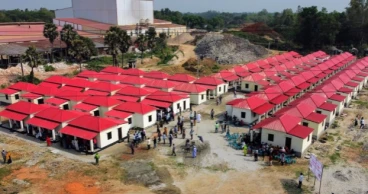Hunger
Is Midnight Snacking Bad for You?
If you find yourself reaching for a snack in the dead of night, you are not alone. Midnight cravings are a common occurrence, often driven by various factors that go beyond simple hunger. It involves a complicated interaction and psychological and physiological factors. Let's dive into the intricacies of late-night snacking, exploring the reasons behind it, its impact on health, and practical ways to curb those midnight urges.
Reasons for Midnight Snack Cravings
Unbalanced Meal Schedules
Unbalanced meal schedules wreak havoc on the body's internal rhythm, causing a disconnection between hunger signals and actual meal times. When meals are irregular, the body, accustomed to a routine, may erroneously interpret these fluctuations, triggering nighttime hunger pangs. This disruption becomes a significant factor in midnight snack cravings.
Hormonal Fluctuations
Fluctuations in cortisol and ghrelin levels are pivotal in orchestrating hunger and satisfaction. They play a role in nocturnal cravings. Elevated cortisol, known as the "stress hormone," intensifies at night, prompting desires for sweet or fatty treats.
Simultaneously, heightened ghrelin is the "hunger hormone." It amplifies your appetite during the nocturnal hours and fuels the urge for midnight snacks.
Read more: 5 Yummy Homemade Pizza Recipes for Kids
Inadequate Daytime Eating
Skipping meals or inadequate calorie intake triggers heightened evening hunger. In the absence of sufficient daytime nourishment, the body enters "starvation mode" and slows metabolism to conserve energy. This often results in intense late-night hunger, particularly if dinner is skipped or kept light.
Stress and Emotional Eating
Stress induces cravings for comfort foods, rich in sugar, fat, and salt. Elevated cortisol levels during stress can increase appetite and desire for unhealthy foods. While these provide momentary pleasure, long-term consumption may contribute to weight gain and other chronic health issues.
Dehydration
Sometimes, thirst may be misconstrued as hunger, prompting unnecessary snacking. Dehydration can send signals to the brain resembling hunger, even when food is not required. Maintaining adequate water intake throughout the day aids in distinguishing thirst from hunger and diminishes the likelihood of late-night snack cravings.
Read more: 10 Healthy Iftar Drinks for Breaking Ramadan Fasting
1 year ago
Food for All: AL Manifesto Emphasizes Agricultural Development for a Hunger-Free Bangladesh
"Food for All" is the core goal and commitment of the Awami League. The manifesto pledges to build a hunger-free Bangladesh. On Wednesday (December 27), the Awami League announced this manifesto for the 12th national parliamentary election.
Agriculture is a primary driving force of Bangladesh's economy and livelihoods. Agriculture plays a crucial role not only in fulfilling the food and nutritional needs of the population but also in providing employment in rural areas, supplying raw materials to industries, and increasing export earnings. Following independence, Father of the Nation Bangabandhu Sheikh Mujibur Rahman, initiated an agricultural revolution by taking ground-breaking steps to enhance production and ensure food security, giving utmost importance to the development of agriculture and farmers. Currently, under the leadership of Bangabandhu's daughter, Sheikh Hasina, the Awami League government also prioritizes agriculture in state governance. With the commitment of "Food for All," the party emphasizes agricultural development in its manifesto for the 12th national parliamentary election.
PM Hasina unveils AL election manifesto promising dev, peace, prosperity
In the fiscal year 2022-23, rice production surpassed all previous records. Currently, Bangladesh ranks third globally in the production of rice, vegetables, and onions. Additionally, it holds the second position in jute production, fourth in tea, and seventh in potato production. Significant progress has been made in cultivating both domestic and foreign fruits. Farmers are encouraged to cultivate profitable but unconventional crops like coffee, cashew nuts, black pepper, malta (a type of citrus), and dragon fruit. The per capita fruit consumption rate, which was 55 grams in 2006, increased to 85 grams in 2023. In the last 15 years, 699 new crop varieties resilient to adverse environments and 708 technologies have been developed. The mechanization of agriculture is underway to modernize it. From 2010 to 2023, nearly 133,000 agricultural machineries, including combine harvesters, reapers, seeders, and power tillers, have been distributed to farmers at subsidized prices. A 3,000 crore taka agricultural mechanization project is ongoing. Overall, the country's agricultural system is transitioning from subsistence farming to commercial agriculture.
AL to announce election manifesto Wednesday
To maintain this trend, the Awami League, led by Prime Minister Sheikh Hasina, pledges to follow sustainable development strategies based on planned initiatives. The strategy aims to meet the growing population's nutritional needs, ensure the supply and accessibility of nutritious food for all, develop commercial agriculture, expand agriculture-dependent industries, improve rural infrastructure, increase and diversify exports of agricultural and non-agricultural products, and enhance the quality of life in rural communities through poverty alleviation. The annual budget allocation will be increased, and private investment in the rural sector will be encouraged.
Awami League’s Commitment
"Food for All" remains the Awami League's primary goal and commitment. The trend of following sustainable development strategies, based on a contextualized plan for the development of agriculture, farmers, and the rural economy, will continue. The strategy includes ensuring nutrition for the growing population, supplying and accessing nutritious food for everyone, developing commercial agriculture, expanding agriculture-dependent industries, improving rural infrastructure, increasing and diversifying exports of agricultural and non-agricultural products, and enhancing the living standards of rural communities through poverty alleviation. The annual budget allocation will be increased, and private investment in the rural sector will be encouraged.
The daughter of Bangabandhu pledges to expand the initiatives already taken to increase agricultural production. The provision of agricultural loans at 4% concessional interest will continue; the central bank will refinance commercial banks at a 0.5% rate, encouraging them to distribute more agricultural loans. The Awami League will continue to provide assistance and subsidies for agricultural production and investment in agricultural inputs. Easy access to and availability of agricultural machinery will be ensured to alleviate labor shortages in agriculture and increase productivity. Subsidies on agricultural machinery will continue.
The Awami League government has already implemented a policy to bring all land under cultivation to further increase agricultural production. Sheikh Hasina's commitment is that no land will remain uncultivated. Emphasis will be placed on developing an integrated agricultural system.
Furthermore, to build a smart, agriculture-dependent Bangladesh, strategies will be adopted for commercial agriculture, biotechnology, genetic engineering, robotics, artificial intelligence, and nano-technologies, as well as for developing the rural non-agricultural sector and facing globalization challenges. The focus on modernizing agriculture, innovating technology, and increasing opportunities and facilities for agricultural research will continue. Environmental protection will also be seriously considered in the use of various products in agriculture.
Read more: Govt prepared to ensure food security into the future: Agriculture Minister
Not only agriculture, but also the fisheries and livestock sectors are immensely important for ensuring food security, meeting nutritional needs, creating employment, alleviating poverty, expanding export trade, and overall socio-economic development in Bangladesh. To meet the animal protein demand of the growing population, create entrepreneurs and employment, and keep the rural economy active, Sheikh Hasina's government is also giving equal importance to the fisheries and livestock sectors. The Awami League's commitments in this continuity are:
1. To increase the productivity of livestock by one and a half times by 2028.
2. To establish commercial dairy and poultry farms, increase self-employment, and alleviate poverty by providing loans on easy terms, necessary subsidies, technical advice, and policy support.
3. To increase the domestic production of quality animal feed ingredients, expand processing technology, and ensure reasonable prices.
4. To diversify, process, and expand export-oriented industries of animal products.
5. To expand farm mechanization and automated production systems in preparation for the Fourth Industrial Revolution.
6. To increase fish production from 4.915 million metric tons to 5.840 million metric tons and to raise the per capita fish consumption from 67.8 grams/day to 75 grams/day by ensuring sustainable fish production and achieving food security through maximum utilization of resources.
7. To strengthen sustainable management of marine fisheries resources and ensure responsible fishing for the development of the blue economy.
8. To adopt projects/programs based on delta hotspots for coping with the adverse effects of climate change, improving the quality of life of local communities, adaptation, and capacity building.
9. To reduce fish waste by 10% and create employment for about 600,000 people in the next five years by ensuring sustainable use of fish resources through value chain development and diversifying value-added fish and fishery products.
10. To encourage the private sector to increase fish and fishery product exports and expand new markets abroad by organizing Fish Expos and establishing exclusive economic zones for fishery product processing, aiming to increase export earnings from 4,790 crore to 15,000 crore taka.
11. To expand ongoing programs for increasing livestock production and to enhance opportunities and facilities for processing, marketing, and value addition of these products.
12. To continue fish farming in ponds and, where possible, in rice fields by providing quality fish fry, food, and disease treatment.
13. To provide easy access to capital, electricity connections, and other facilities for farmers.
Read more: Food security remains protected amid int’l crisis: PM Hasina tells Parliament
2 years ago
More people can't afford nutritious food and 148 million children are stunted by hunger, UN says
The U.N. delivered grim news on global food security Wednesday: 2.4 billion people didn’t have constant access to food last year, as many as 783 million faced hunger, and 148 million children suffered from stunted growth.
Five U.N. agencies said in the 2023 State of Food Security and Nutrition report that while global hunger numbers stalled between 2021 and 2022 many places are facing deepening food crises. They pointed to Western Asia, the Caribbean and Africa, where 20% of the continent’s population is experiencing hunger, more than twice the global average.
“Recovery from the global pandemic has been uneven, and the war in Ukraine has affected the nutritious food and healthy diets,” Qu Dongyu, director-general of the Food and Agriculture Organization said in a statement. “This is the `new normal’ where climate change, conflict, and economic instability are pushing those on the margins even further from safety.”
FAO chief economist Maximo Torero said the FAO food price index has been declining for about 15 months, but “food inflation has continued.” But he said not knowing if the deal that has enabled Ukraine to ship 32 metric tons of grain to world markets and is trying to overcome obstacles to Russian grain and fertilizer shipments will be renewed when it expires on July 17 “is not good for the markets.”
UN warns its development goals for 2030 are in trouble and 575 million people will remain very poor
If it isn’t renewed immediately “you will have a new spike for sure” in food prices, but how much and for how long will depend on how markets respond, he said.
According to the report, people’s access to healthy diets has deteriorated across the world.
More than 3.1 billion people – 42% of the global population – were unable to afford a healthy diet in 2021, an increase of 134 million people compared to 2019, it said.
Torero told a news conference launching the report that reducing the number of people eating unhealthy diets “is a big challenge, because it’s basically telling us that we have substantially to change the way we use our resources in the agricultural sector, in the agri-food system.”
According to the latest research, he said, between 691 million and 783 million people were chronically undernourished in 2022, an average of 735 million which is 122 million more people than in 2019 before the COVID-19 pandemic began.
Eliminate legal barriers to women owning land: UN chief
Torero said U.N. projections for 2030 indicate that 600 million people will still be suffering from chronic undernourishment in 2030, far from the U.N. development goal of achieving “Zero Hunger” by that date.
In the report’s foreword, the heads of FAO, the World Food Program, the International Fund for Agricultural Development, the U.N. children’s agency UNICEF and the World Health Organization wrote that achieving Zero Hunger “poses a daunting challenge.” They called for redoubled efforts “to transform agri-food systems and leverage them” to reach the target.
As for children, the report says they are continuing to suffer from malnutrition, with not only 148 million younger than 5 stunted but 45 million too thin for their height or “wasted,” while 37 million youngsters were overweight.
Torero said the five agencies also looked at increased urbanization and found that people in rural and semi-urban areas are also consuming mass market products.
“Normally, we used to believe that rural people will consume what they produce, but that’s not the case,” he said, explaining that in rural areas about 30% of the family’s food basket is purchased from the market, and in semi-urban and urban areas it is higher, which has implications for nutrition because of the consumption of more processed foods.
WFP chief economist Arif Husain told reporters in a virtual briefing that in 2022 when the war in Ukraine was ongoing the food situation didn’t get worse because the donor community stepped up with about $14.2 billion, and the agency was able to provide aid to 160 million people, up from 97 million in 2019.
Stop targeting truth, truth-tellers: UN Chief on World Press Freedom Day
“My concern is that moving forward we are looking at huge funding cuts,” he said, citing WFP donations of just $4.2 billion by last week, 29% lower than at the same time last year.
2 years ago
PM Hasina's Ashrayan project is enabling Bangladesh’s inclusive growth, India Today writes
Bangladesh Prime Minister Sheikh Hasina's ‘Ashrayan Project’ under which homes are built for homeless and displaced people in Bangladesh, has played a key role in achieving the goals of poverty eradication, hunger eradication, gender equality and women's empowerment, among others, India’s leading English-language magazine India Today writes.
Her innovative Shelter Scheme, to transform Bangladesh into a developed and prosperous country by 2041, has been able to bring about positive changes in inclusive development by aiming to provide houses for landless, homeless, and marginalized people in 64 districts of the country, writes the magazine in its April 15 issue.
Whereas examples of low-interest loans for land purchase are found in several countries around the world, Bangladesh becomes the first country to offer free land ownership with houses to its marginalized citizens in order to bring its backward communities into the mainstream, India Today notes.
Read: 4 lakh coastal people took refuge at Ashrayan homes during Sitrang: PMO
“Beneficiaries under this scheme are not only provided with accommodation, but they are also provided with various training, daily allowances during training, and loans after training to make them economically self-reliant,” the report states.
“The scheme includes empowering women by giving them half ownership of land and houses, providing free electricity connection, providing clean water by installing one shallow tube well for every 10 families, and providing food assistance under three months of VGF to the resettled families initially,” it reads.
The India Today report also lauded PM Hasina’s development, known as the "Sheikh Hasina model".
The 'Ashrayan Project' is a unique example of how a house can be a major tool for overall family welfare and social development.
Read: Ashrayan Project: Govt thoroughly scrutinizing “irregularities”
In its report, India Today highlighted the experience of two beneficiaries of the project.
For 30 long years, Moksedul, a brick kiln labourer, waited for a house that he could call his own.
His long-held desire has been granted, as he has been assigned a semi-furnished house in his own name.
Moksedul told India Today that he can live very well with his family now.
Meanwhile, sixty-five-year-old Piara Begum is a resident of Patharghata in Barguna who lost her family home to the river thirty years ago.
Read: No laxity in costruction of Ashrayan houses to be tolerated: Project Director
She used to live with her husband on the banks of the river until he died of cancer 16 years ago.
“Finally, Piara Begum's misery has come to an end after she is allotted a house built by the Bangladesh government on the occasion of ‘Mujib centenary’ under the ‘Ashrayan' scheme.” India Today writes.
“I have been suffering all my life. I never dreamed of a house. Now, I have got a semi-furnished house with land. The prime minister has given me a house. I am very happy. As long as I live, I will pray for the prime minister,” she told India Today.
The “Ashrayan” project was undertaken in 1997 under the leadership of Prime Minister Sheikh Hasina. And since its inception, approximately 5,07,244 landless and homeless families have been rehabilitated at various stages under this shelter initiative.
Read More: I’m everyone’s PM irrespective of party affiliation, says Hasina
Through this initiative, the society's backward community has been given access to semi-finished housing and two decimals of land.
2 years ago
Multiple crises set to plunge more children into poverty, ILO and UNICEF report warns
The number of children without access to social protection is increasing year-on-year, leaving them at risk of poverty, hunger and discrimination, according to a new report released today by the International Labour Organization (ILO) and UNICEF.
According to the report, an additional 50 million children (aged 0-15) missed out on a critical social protection provision – specifically, child benefits (paid in cash or tax credits) – between 2016 and 2020, driving up the total to 1.46 billion children under 15 globally.
“Ultimately, strengthened efforts to ensure adequate investment in universal social protection for children, ideally through universal child benefits to support families at all times, is the ethical and rational choice, and the one that paves the way to sustainable development and social justice,” Shahra Razavi, director of Social Protection Department at the ILO, said.
Child and family benefit coverage rates fell or stagnated in every region in the world between 2016 and 2020, leaving no country on track to achieve the Sustainable Development Goal of achieving substantial social protection coverage by 2030, as per the report.
In Latin America and the Caribbean, for example, coverage fell significantly from approximately 51 percent to 42 percent. In many other regions, coverage has stalled and remains low.
In Central and South Asia, East Asia and Southeast Asia, Sub-Saharan Africa, Western Asia, and North Africa coverage rates have been at around 21 percent, 14 percent, 11 percent and 28 percent respectively since 2016.
Failure to provide children with adequate social protection leaves them vulnerable to poverty, disease, missed education, and poor nutrition, and increases risk of child marriage and child labour.
Globally, children are twice as likely as adults to live in extreme poverty – those struggling to survive on less than US$ 1.90 (PPP*) a day – approximately 356 million children.
A billion children also live in multidimensional poverty – meaning without access to education, health, housing, nutrition, sanitation, or water.
Children living in multidimensional poverty increased by 15 percent during the Covid-19 pandemic, reversing previous progress in reducing child poverty and highlighting the urgent need for social protection.
Moreover, the pandemic highlighted that social protection is a critical response in times of crisis.
Nearly every government in the world either rapidly adapted existing schemes or introduced new social protection programmes to support children and families, but most fell short of making permanent reforms to protect against future shocks, according to the report.
“As families face increasing economic hardship, food insecurity, conflict, and climate-related disasters, universal child benefits can be a lifeline,” said Natalia Winder-Rossi, UNICEF Director of Social Policy and Social Protection.
“There is an urgent need to strengthen, expand and invest in child-friendly and shock-responsive social protection systems. This is essential to protect children from living in poverty and increase resilience particularly among the poorest households.”
The report emphasizes that all countries, irrespective of their level of development, have a choice: whether to pursue a “high-road” strategy of investment in reinforcing social protection systems, or a “low-road” strategy that misses out on necessary investments and will leave millions of children behind.
To reverse the negative trend, ILO and UNICEF urge policymakers to take decisive steps to attain universal social protection for all children, including:
· Investing in child benefits which offer a proven and cost-effective way to combat child poverty and ensure children thrive.
· Providing a comprehensive range of child benefits through national social protection systems that also connect families to crucial health and social services, such as free or affordable high-quality childcare.
· Building social protection systems that are rights-based, gender-responsive, inclusive, and shock responsive to address inequities and deliver better results for girls and women, migrant children, and children in child labour for example.
· Securing sustainable financing for social protection systems by mobilizing domestic resources and increasing budget allocation for children.
Strengthening social protection for parents and caregivers by guaranteeing access to decent work and adequate benefits, including unemployment, sickness, maternity, disability, and pensions.
2 years ago
Thrive: A Non-Profit Organization’s Attempt to Answer Hunger
Food is one of the most important basic human rights. Even though global food production is more than the demand, the geopolitical and distributional bureaucracy causes 10% of the global population to go hungry each day. Against the backdrop of such a pressing issue, one organization is aiming to challenge the status quo with one child and one meal at a time. Here’s the inspiring story of Thrive.
What is Thrive?
Thrive is a 501c3 and Bangladesh Registered Trust that currently operates in Bangladesh and the Philippines. Thrive was co-founded and started by Priscilla Heffelfinger, Regina Landor, and Gina Gabel. The main goal of the organization is to provide nutritious meals to school-going children every day.
The Story of Thrive
It all started back in 2012. Priscilla Heffelfinger has just moved to Dhaka, accompanying her husband, who was the country director of CDC and had a role with ICDDR, B. Priscilla Heffelfinger, along with Regina Landor and Gina Gabel, saw hungry children and knew they wanted to help.
Read More: Majority of children with disabilities are not enrolled in any formal education: Survey
They asked local schools what they needed most, and the resounding response was food. The children were either not showing up or were too hungry to learn took the first initiative for a definitive answer to student hunger.
Thrive grew, but not overnight. It took the work and dedication of many volunteers willing to give their time to help hungry kids. While Thrive began as an expat start-up, it grew due to the generous support of the Bangladesh community.
Local leaders Amna Rahman, Sadia Moyeen, and Kanwal Bhagat, who joined in 2013, propelled Thrive’s work by engaging local individuals and companies to commit financial support, in-kind donations, and their volunteer talents to expand our work to feed more needy schoolchildren.
Read More: RU teachers ‘beat’ students on hunger strike
But there were a lot of constraints while starting. The idea was to help socially neglected children by means of support. But support how exactly?
The Need for Food
While doing groundwork, Priscilla and her team found that the most pressing need for growing children is the lack of adequate micro and macro nutrients. Social welfare schools set up for economically challenged students pointed out that the immediate need for such institutes isn’t often money. Rather a meal since a fair share of students are unfed or half fed.
Going hungry often challenges these students to reevaluate their priorities. As a result, there are a large number of student dropouts who opt for wage-earning instead of going to school.
Read More: Imprisoned Egyptian activist calls off hunger strike
Priscilla and her team thought of this as the exact opportunity. Having worked in the development sector for over 20 years, Priscilla understood the imminent need. A mix of two basic human rights is fulfilled through food.
How Does Thrive Work?
Thrive is different from traditional NGOs or INGOs in Bangladesh in the sense that it was initially an expat-led social venture that aimed to work with students from slum areas. The venture has been supported by both local and international well-wishers and has seen rapid growth over the years.
Currently, Thrive serves nutritious meals to over 12000 students each week in Bangladesh and the Philippines. Thrive claims that there is an imminent wait list of another 3000 students waiting to be incorporated into their meal plan.
Read More: Global hunger numbers rose to as many as 828 million in 2021: UN Report
Now feeding hungry children and school performance may seem unrelated. But from the socio-economic concept of Bangladesh, where 50 million people live in extreme poverty, it's not surprising that child labor is ever so prevalent. These children turn into breadwinners for themselves and their families while they should have been studying.
With a nutritious meal each day, hunger is addressed. The balanced diet ensures children are getting their essentials which act as brain fuel. The culmination is increased concentration, focus, physical and mental development as well as increased attendance in classes.
2 years ago
19 ‘hunger hotspots’ may trigger major social turmoil
"The war in Ukraine has compounded problems that have been brewing for years: climate disruption, the Covid-19 pandemic, and the deeply unequal recovery," said UN Secretary General Antonio Guterres. The world is talking about a global hunger crisis and even in Bangladesh; the PM Sk. Hasina has said that there is a serious threat to food security in 2023.
"There is a real risk that multiple famines will be declared in 2022. And 2023 could be even worse," Guterres added. Till date however no famine has been declared but the threat remains. As it happens, the Horn of Africa is in dire straits and millions face severe hunger. The World Food Programme estimates that 276 million are experiencing severe food insecurity.
Fertilizer and energy prices rose in 2021 and 2022 impacting on harvests compounding the problem. "No country will be immune to the social and economic repercussions of such a catastrophe."
Prime Minister Sheikh Hasina said while mentioning the food shortage crisis that Bangladesh will have to become self-reliant in all aspects of food security. "We have soil and manpower. So, we have to take initiative from now on so that Bangladesh never has to face famine and food insufficiency-like situations. We will have to grow our food," she said. "We have to be self-reliant by growing food for ourselves and we have to give some produced grains to the neighbours."
FAO and WFP warnings
FAO and the World Food Programme (WFP) have said that acute food insecurity could get worse in 19 countries termed “hunger hotspots”. The period will be from October 2022 to January 2023.
Afghanistan, Ethiopia, Nigeria, South Sudan, Somalia and Yemen remain at the highest concern level requiring the most urgent attention.
Discussing Afghanistan, UN officials said they fear that lives lost due to hunger may already have occurred and about 6 million people could be in Emergency conditions by November. With a harsh winter ahead, things could get worse.
In Ethiopia, the situation is acute particularly in Tigray from the end 2021 but interventions have also been suspended as war has broken out. With five failed rainfalls, over 20 million are considered to be in acute food insecurity. Nigeria too is in a bad shape and nearly 20 million people could be in a famine situation.
Somalia and southern Sudan are both experiencing extreme food insecurity. Yemen will be in great difficulties but the situation appears to be easing slightly. The Democratic Republic of the Congo, Haiti, Kenya, the Sahel region, the Sudan and the Syrian Arab Republic remain zones of high concern.
Central African Republic, Pakistan, Guatemala, Honduras, and Malawi have been added in the list of hotspot countries, since the June 2022 edition. Sri Lanka, Zimbabwe and Madagascar meanwhile remain hunger hotspots.
Hunger hotspots: The reasons why
Read: Global hunger numbers rose to as many as 828 million in 2021: UN Report
Not one but several factors are responsible and they are linked to each other. In fact, conflicts, natural disasters, climate change issues, weak governance and impact of the European Russo-Ukraine war have all contributed to create a global disaster scenario rarely seen since WW 2. While it is eroding confidence in a globalized economic system, the options to that have not been seen either.
Most world leaders and their technocrat advisers appear to be unable to advise them meaningfully. Basically, the situation has rapidly gone out of various governments’ hands.
Inflation, shortage of foreign exchange for imposing essential goods, growing risks of recessions, and significant slowdown in major economies is affecting all. When the European Union and China slows down, the world basically does also. When poverty and acute food insecurity increases, socio-political turmoil is inevitable too as the state system faces collapse in one form or another.
6 of the hotspots are in very bad shape – Afghanistan, Ethiopia, Nigeria, Somalia, South Sudan and Yemen – and unless humanitarian actions are taken, more starvation and death will occur. Rests are not facing death and starvation immediately but escalating to an extreme level rapidly is very possible.
South Asia
Two countries have been named as “hotspots” in South Asia- Pakistan and Sri Lanka. While Sri Lanka has been undergoing turmoil for at least a year or more, Pakistan has been a recent entrant after its devastating floods. Sri Lanka has seen a massive socio-economic turmoil and its agriculture collapsed after a disastrous decision to introduce organic fertilizers. This was largely because it couldn’t afford to import chemical fertilizers as it had run out of foreign exchange reserves and in severe debt.
Pakistan was a victim of severe flooding caused by what most experts say are climate change factors. But Pakistan is also a victim of poor governance mechanisms and weak ability to respond to humanitarian emergencies.
Other countries of South Asia are still safe but all will remain vulnerable as governance and macro-economic problems plague them all with India the least.
A sort of transition is on which shows that conventional globalization has left most poor zones exposed to risks. Most factors responsible for hunger are long term and apart from mis-governance are located in the wealthy part of the world. However, with military and economic power deciding the relationship, hotspots can only be reduced if at all but this isn’t about to go away, particularly as climate change begins to exert its impact.
3 years ago
Hunger grips Burkina Faso due to increasing jihadi violence
Martine Roamba’s 10-month-old daughter weakly tugs at her mother’s breast searching for milk.
The malnourished baby has been struggling to feed since birth as her mother hasn't had enough to eat to produce sufficient breastmilk since fleeing her village in northern Burkina Faso last year when jihadis started killing people.
Seated on a hospital bed with other severely malnourished children and their parents on the outskirts of Burkina Faso's capital, Ouagadougou, 30-year-old Roamba tries to calm her crying daughter.
Also read: Gold mining site blast reportedly kills 59 in Burkina Faso
“It’s very worrying and we’re praying to God that the baby doesn’t deteriorate into an even worse situation,” she said.
Hunger is soaring across conflict-ridden Burkina Faso, a result of increasing violence linked to al-Qaida and the Islamic State group, which has killed thousands and displaced millions, preventing people from farming. Some 3.5 million people are food insecure, with nearly 630,000 expected to be on the brink of starvation, according to the latest food security report by the government and U.N. agencies. This is an 82% increase from last year of people facing emergency hunger.
“The nutrition situation in (the country) is deteriorating more and more, there are more and more people in need,” said Claudine Konate, a nutrition specialist for the U.N. Children's Agency, UNICEF. The country has to prepare for a growing crisis, she said.
At the hospital in Ouagadougou, the number of severely malnourished children arriving has doubled from two years ago and there isn’t enough space or staff to care for them, said Clarisse Nikiema, head of nutrition at the hospital.
“Because they were displaced, they are deeply impoverished and can’t feed their families, so children become malnourished,” she said. Sometimes after recovering, families refuse to leave because they don’t want their children going hungry at home where there’s no food, she said.
In January, mutinous soldiers ousted Burkina Faso’s democratically elected president, and the ruling junta says that restoring security is their top priority. However, attacks have since increased with an 11% rise in incidents in February, according to the U.N. The violence is driving more people closer to starvation, say experts.
The situation is most dire in the northern Sahel region, where cities like Djibo have until recently been besieged by jihadi rebels for months, restricting the delivery of food aid. Other towns like Gorom Gorom, have almost no operating health centers. Only two out of 27 in the district are fully functioning, said Jean Paul Ouedraogo, representative for the Italian-based aid group Lay Volunteers International Association.
Jihadi rebels are also expanding and pushing south and west into Burkina Faso's breadbasket, stealing crops and livestock and chasing people from their rural farms and into cities.
The decreasing supply and increase in demand is causing prices to spike. A bag of 100 kilograms of corn has nearly doubled since last year from $30 to $50, say locals. Aid organizations are bracing for more price hikes because of the war in Ukraine. Burkina Faso buys more than a third of its wheat from Russia, according to the U.N., and while the impact is not yet visible, humanitarians say it’s a concern.
“The crisis in Ukraine is also likely to impact soaring grain prices, making an already bad situation worse,” said Gregoire Brou, country director for Action Against Hunger in Burkina Faso. Aid for the country is already underfunded — last year’s humanitarian response plan received less than half of the requested $607 million, according to the UN — and now agencies say donors have indicated there could be a 70% cut to funding in order to support operations in Ukraine.
Also read:Soldiers declare military junta in control in Burkina Faso
Meanwhile hunger is affecting virtually everyone in the country, even those trying to defend it. During a trip to the northern town of Ouahigouya, civilians who volunteered to fight alongside the army, told The Associated Press they’re battling jihadis on empty stomachs.
“The volunteers fight for the country, but they fight with hunger,” said one volunteer who spoke on condition of anonymity because he was not authorized to speak to the media. The lack of farming and minimal pay as a volunteer — $8 a month — isn’t enough to subsist on, he said.
Malnourished people are arriving at health centers in Ouahigouya in severe condition and taking longer to recover, said Dr. Gerard Koudougou Kombassere, who works at a hospital in the town. Displaced people are the most affected and malnutrition rates among them are rising, he said. In a makeshift displacement camp in Ouahigouya where some 2,300 people have sought refuge, residents told AP they have received food assistance only once in the past 10 months.
At one of the shelters, Salamata Nacanabo said her family used to eat five times a day when they lived in their village, but now they eat just once. Mimicking the sound of gunshots, the 31-year-old recounts the day jihadis stormed her village killing eight people, seizing everything she owned and forcing her family to flee.
“They stole everything, cattle, food, and they took my goats," she said. “Now it’s very hard to take care of the children.”
3 years ago
Covid-19 pandemic swells number of hungry by more than 50 mn in Asia-Pacific: FAO-UNICEF Report
The state of food security and nutrition in Asia and the Pacific has worsened, as more than 375 million people in the Asia-Pacific region faced hunger in 2020, an increase of 54 million over the previous year, according to a joint report just published by the Food and Agriculture Organization (FAO), and the United Nations Children’s Fund (UNICEF) on Wednesday in Bangkok.
While hunger has increased, so too has inadequate access to nutritious foods, the report said.
According to the 2021 Asia and the Pacific Regional Overview of Food Security and Nutrition, in this region alone, more than one billion people did not have access to adequate food in 2020 – an increase of almost 150 million people in just one year.
The high cost of a healthy diet, and persistently high levels of poverty and income inequality, continue to hold healthy diets out of reach for 1.8 billion people in the Asia and Pacific region.
Read: Children in the Pandemic: Consortium predicts 168,000 to die hungry during crisis
In recent years, progress has stalled in reducing the number of undernourished, and the prevalence of certain nutritional indicators, such as stunting in children under five years of age, was already much too high, as reported last year.
Since then, the situation has worsened. While it is not yet possible to fully quantify the damage done to food security and nutrition by COVID-19, the pandemic has had a serious impact on the region. Even countries that initially reported a limited number of COVID-19 cases experienced the negative effects of the containment measures, combined with people’s health concerns, that led to a major contraction of economic activity in this region and worldwide. Disruption in food supply chains only added to the problems.
The situation could have been worse without the response of governments and the impressive social protection measures they put in place during the crisis. In building back better food environments, future agri-food systems will have to provide better production, better nutrition, a better environment and better lives.
Read: Millions of hungry Americans turn to food banks for 1st time
To do that, FAO and UNICEF state the focus must revolve around meeting the needs of small-scale, family farmers and indigenous people in the region. Food systems must also prioritize the dietary needs of vulnerable groups, including young children and women.
Commitments have been made to ensure recovery and there are opportunities to begin the hard work of advancing food security and nutrition through transforming agri-food systems such as the United Nations Food Systems Summit, the Nutrition for Growth Summit and the 2021 United Nations Climate Change Conference (COP26). Implementing these commitments will be needed to meet the second Sustainable Development Goal, SDG2, to eradicate food insecurity and malnutrition.
4 years ago
‘God have mercy’: Tigray residents describe life under siege
As food and the means to buy it dwindled in a city under siege, the young mother felt she could do no more. She killed herself, unable to feed her children.
In a Catholic church across town, flour and oil to make communion wafers will soon run out. And the flagship hospital in Mekele, the capital of Ethiopia’s Tigray region, wrestles with whether to give patients the expired medications that remain. Its soap and bleach are gone.
A year of war and months of government-enforced deprivation have left the city of a half-million people with rapidly shrinking stocks of food, fuel, medicine and cash. In rural areas, life is even grimmer as thousands of people survive on wild cactus fruit or sell the meager aid they receive. Man-made famine, the world’s worst hunger crisis in a decade, has begun.
Despite the severing of almost all communication with the outside world, The Associated Press drew on a dozen interviews with people inside Mekele, along with internal aid documents, for the most detailed picture yet of life under the Ethiopian government’s blockade of the Tigray region’s 6 million people.
Amid sputtering electricity supplies, Mekele is often lit by candles that many people can’t afford. Shops and streets are emptying, and cooking oil and baby formula are running out. People from rural areas and civil servants who have gone unpaid for months have swelled the ranks of beggars. People are thinner. Funeral announcements on the radio have increased.
“The coming weeks will make or break the situation here,” said Mengstu Hailu, vice president for research at Mekele University, where the mother who killed herself worked.
He told the AP about his colleague’s suicide last month as well as the deaths of two acquaintances from hunger and a death from lack of medication. “Are people going to die in the hundreds and thousands?” he asked.
Read: 'I just cry': Dying of hunger in Ethiopia's blockaded Tigray
Pleas from the United Nations, the United States, the European Union and African nations for the warring sides to stop the fighting have failed, even as the U.S. threatens new sanctions targeting individuals in Africa’s second-most populous nation.
Instead, a new offensive by Ethiopian and allied forces has begun in an attempt to crush the Tigray fighters who dominated the national government for nearly three decades before being sidelined by Prime Minister Abiy Ahmed, the 2019 Nobel Peace Prize winner.
Ethiopia is one of the top recipients of U.S. humanitarian aid. The government in Addis Ababa, fearing the assistance will end up supporting Tigray forces, imposed the blockade in June after the fighters retook much of Tigray, then brought the war into the neighboring Amhara and Afar regions. Hundreds of thousands are now displaced there, widening the humanitarian crisis.
After the AP last month reported the first starvation deaths under the blockade, and the U.N. humanitarian chief called Ethiopia a “stain on our conscience,” the government expelled seven U.N. officials, accusing them of falsely inflating the scale of the crisis. The expulsions were “unprecedented and disturbing,” the U.S. said.
Just 14% of needed aid has entered Tigray since the blockade began, according to the U.N., and almost no medicine at all.
“There is no other way to define what is happening to the people of Tigray than by ethnic cleansing,” InterAction, an alliance of international aid groups, said this month of the conflict marked by mass detentions, expulsions and gang-rapes.
“The Tigrayan population of 6 million face mass starvation now,” former U.N. humanitarian chief Mark Lowcock wrote in a separate statement.
In response to questions, the spokesperson for the Ethiopian prime minister’s office, Billene Seyoum, again blamed Tigray forces for aid disruptions and asserted “the government has worked relentlessly to ensure humanitarian aid reaches those in need.” She did not say when basic services would be allowed to Tigray.
At Tigray’s flagship Ayder referral hospital, Dr. Sintayehu Misgina, a surgeon and the vice chief medical director, watches in horror.
Patients sometimes go without food, and haven’t had meat, eggs or milk since June. Fuel to run ambulances has run out. A diesel generator powers equipment for emergency surgeries only when fuel is available.
Read: Ethiopia calls “all capable” citizens to fight in Tigray war
“God have mercy for those who come when it’s off,” he said.
No help is in sight. A World Health Organization staffer told Sintayehu there was nothing left to give, even though a warehouse in neighboring Afar was full of life-saving aid.
Scores of badly malnourished and ill children have come to the hospital in recent weeks. Not all have survived.
“There are no drugs,” said Mizan Wolde, the mother of a 5-year-old patient. Mehari Tesfa despaired for his 4-year-old daughter, who has a brain abscess and is wasting away.
“It’s been three months since she came here,” he said. “She was doing OK, then the medication ceased. She is now taking only oxygen, nothing else.”
Across Tigray, the number of children hospitalized for severe acute malnutrition has surged, according to the U.N. children’s agency — 18,600 from February to August, compared to 8,900 in 2020. The U.N. says hospitals outside of Mekele have run out of nutrition supplies to treat them.
“According to colleagues in the medical and agricultural sector, hundreds (of people) are dying each day, that’s the estimation,” Mekele University lecturer Nahusenay Belay said. He said one acquaintance died from lack of diabetes medication, and a young relative in the city’s outskirts starved to death.
“I’m surviving by the help of family and friends like anyone else,” he said.
Prices for essential goods are spiking. The U.N. last week said cooking oil in Mekele had shot up more than 400% since June and diesel more than 600%. In the town of Shire, swamped by scores of thousands of displaced people, diesel was up 1,200%, flour 300% and salt more than 500%.
The true toll of the deprivation in rural areas of the largely agricultural region is unknown as the lack of fuel prevents most travel.
One internal aid document dated last month and seen by the AP described thousands of desperate people who had fled “trapped and starved communities” near the border with Eritrea, whose soldiers have been blamed for some of the worst atrocities of the war.
Raed: At river where Tigrayan bodies floated, fears of ‘many more’
“Most are able to eat at least one meal per day, largely thanks to the availability of cactus fruit,” the document said. “The situation is likely to deteriorate after September when wild fruits are exhausted.”
A document from another part of Tigray described “too many people to count” trying to sell items such as buckets and soap distributed by humanitarian groups. Some people walked straight from the distribution site to the roadside to sell.
“They have no option as they needed the money to buy food to supplement the inadequate food rations,” the document stated, adding the forecast for famine is “terrifying.”
A Catholic priest in Mekele, the Rev. Taum Berhane, described conditions echoing harsh tales from biblical times. Even before the war, parts of Tigray faced an invasion of desert locusts. Then hostile forces looted and burned crops and shot farmers’ animals. Now, the blockade means people are going hungry despite having money in the bank.
“You see lactating mothers with no milk,” he said. “We see babies dying. I saw myself people eating leaves like goats.”
While the church struggles to support camps for thousands of displaced people, “they are telling us, ‘Let us go back to our villages, even if there’s nothing there. It’s better to die at home.’”
The Catholic bishop in the town of Adigrat told him eight children have died at the hospital there, he said.
The priest, 70 years old and a diabetic, now watches his medication dwindle. His congregation’s spirits, too. With cash in Tigray running out, the collection plate is no longer passed at Mass. The bread for communion will be depleted soon.
“Even if I survive, am I going to preach to a vacuum if all humans perish?” he asked. “The only hope is, to be frank, these people have to stop fighting and talk for sustainable peace.”
4 years ago








.jpg)








